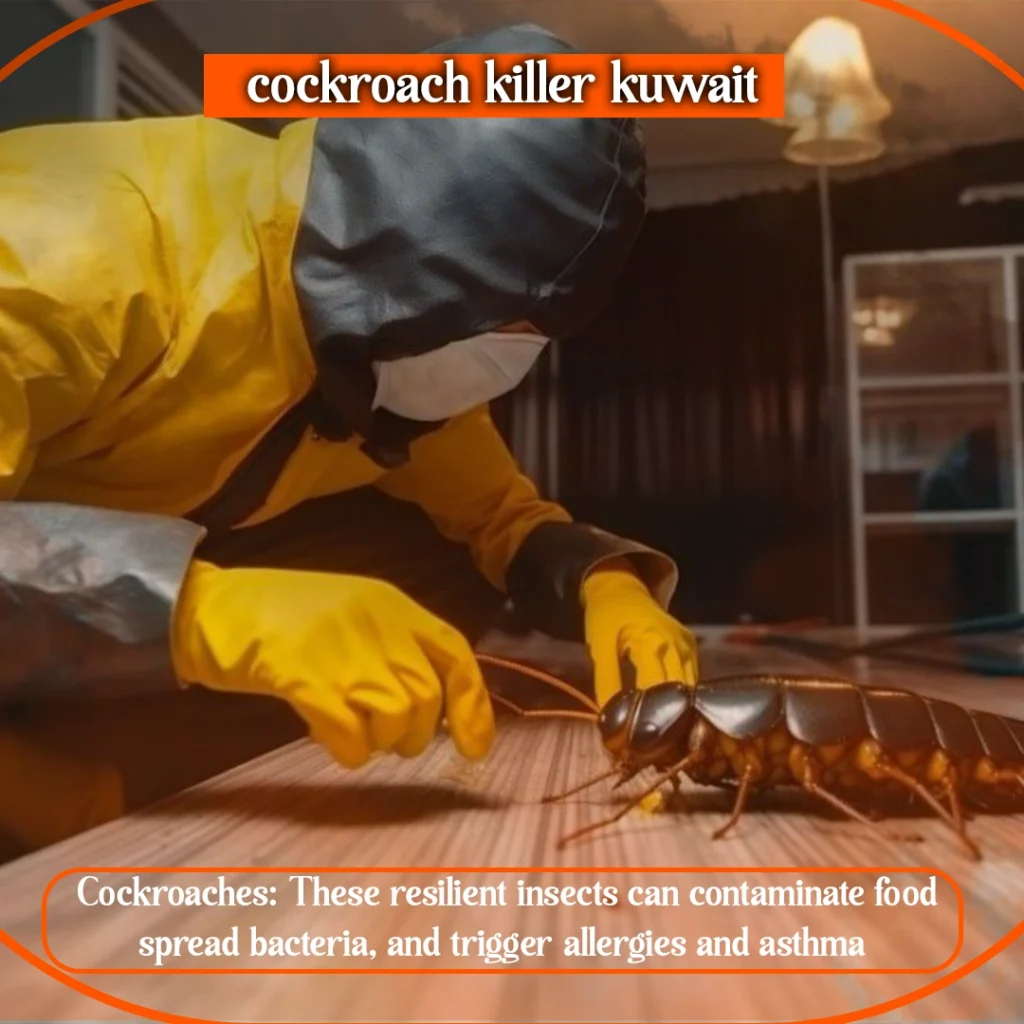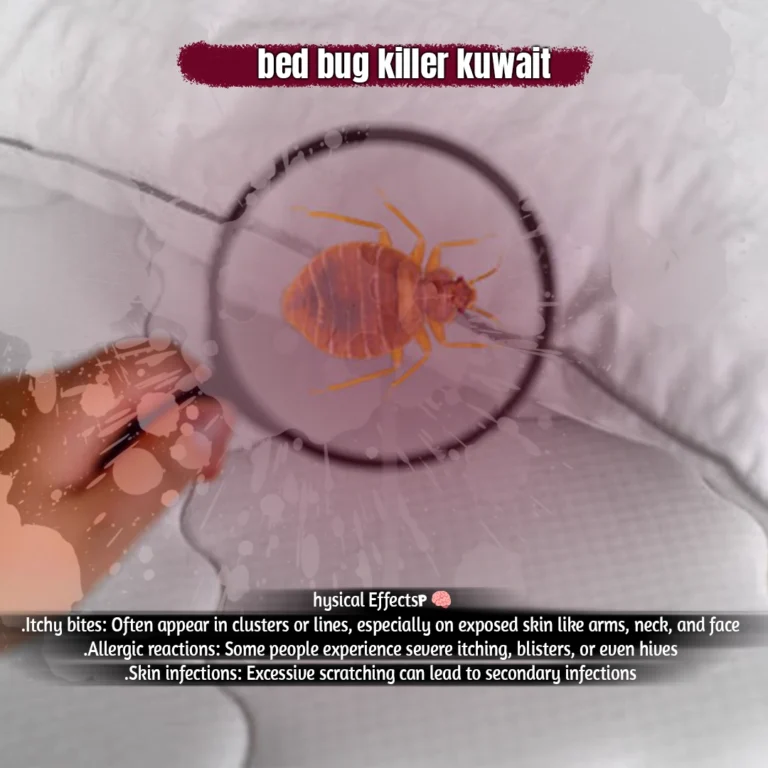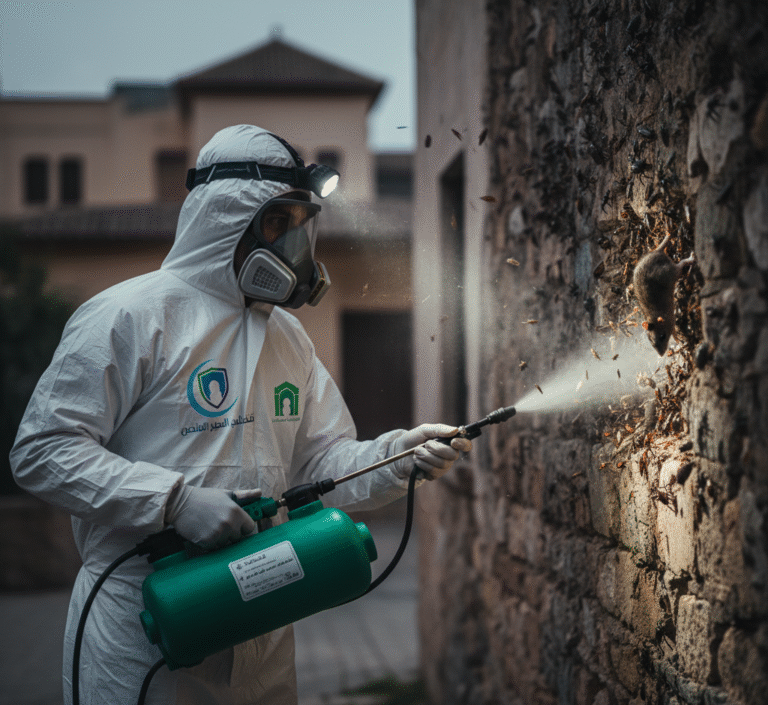cockroach killer spray are among the most annoying and dangerous insects to health. , due to their ability to transmit diseases and reproduce rapidly. Therefore, having a professional cockroach control service like “Cockroach Killer” in Kuwait is essential to ensuring. a clean and healthy environment. It is a professional service specialized in eliminating cockroaches inside homes. , restaurants, or offices, using materials approved by the Ministry of Environment and Health in Kuwait. These include the use of residual spray, bait gel, fine powders, pest control supplies wholesale
and sometimes safe environmental techniques.
To contact us, call 98949693.
Introduction to Cockroach Killer Spray
Cockroach killer spray is a specialized insecticide designed to. effectively eliminate. cockroaches, one of the most common and resilient household pests. The prevalence of cockroaches in urban and suburban environments can be attributed to their ability to adapt to varying conditions.
, making them a nuisance in both residential and commercial spaces. These pests not only cause discomfort through their presence but also pose potential health risks as.
they can transmit diseases and allergens. Consequently, effective pest management becomes essential for maintaining a hygienic environment.
The primary function of cockroach killer spray is to target and eradicate cockroaches on contact or through residual action. These sprays often contain a blend of active ingredients that disrupt the nervous system of the insect. , leading to its rapid demise. Commonly used chemicals in such products include pyrethroids and neonicotinoids, which are favored for their efficacy. and relatively low toxicity to humans and pets when used as directed. The convenience of a spray format allows for precise application, ensuring that the treatment can be directed at known. infestations or areas prone to cockroach entry.
Households often resort to cockroach killer spray as part of a comprehensive pest management strategy. This may stem from a sudden infestation triggered by seasonal changes or increased moisture, which typically lures these insects indoors. Commercial establishments, especially those in the food service industry, must ensure rigorous. pest control measures to comply with health. regulations and maintain customer satisfaction. As a result, understanding the importance of cockroach. killer spray as a tool for pest eradication is crucial for anyone looking to address and prevent cockroach-related issues effectively.
How Cockroach Killer Spray Works
Cockroach killer sprays are formulated to effectively target and eliminate these resilient pests through various mechanisms of action. The effectiveness of these sprays primarily hinges on their active ingredients, which can be classified into categories such as neurotoxins. and contact insecticides. Understanding how these ingredients work provides insight into the overall efficacy of cockroach killer sprays.
One of the primary methods of action utilized by many cockroach sprays is neurotoxicity. Neurotoxic ingredients disrupt the normal functioning of the cockroach’s nervous system. For instance, compounds like pyrethroids and organophosphates engage with neural pathways, leading to paralysis and death. When these active ingredients penetrate the insect’s exoskeleton, they bind to specific receptors in the nervous system, overwhelming their systems with signals that result in uncontrollable muscle spasms and eventual fatality. This targeted approach ensures that the spray is not only harmful to cockroaches but minimizes potential risks to humans and pets when used as directed.

Additionally, many cockroach killer sprays also function as contact insecticides. These sprays kill cockroaches on contact by suffocating them or causing damaging dehydration. The formulation typically contains ingredients that disrupt the protective waxy layer of the cockroach’s exoskeleton, leading to excessive moisture loss. This method highlights the dual-action approach where the combination of neurotoxic and contact properties enhances the effectiveness of cockroach control. The rapid knockdown effect of such sprays makes them particularly appealing for immediate pest control needs.
Overall, the effectiveness of cockroach killer sprays is derived from their ability to prevent these pests from surviving and reproducing. By understanding the mechanisms by which they operate, users can make informed decisions in selecting and applying the appropriate products for cockroach infestation management.
Common Ingredients in Cockroach Killer Spray
Cockroach killer sprays contain a range of active and inactive ingredients that play significant roles in their effectiveness against these pests. One of the most prevalent classes of chemicals found in these products is pyrethroids, which are synthetic versions of natural pyrethrins derived from chrysanthemum flowers. Pyrethroids work by affecting the nervous system of insects, causing paralysis and ultimately leading to their death. Their rapid action and low toxicity to humans and pets make them popular choices in cockroach extermination. Commonly used pyrethroids include permethrin and deltamethrin, both recognized for their effectiveness in treating a variety of household pests.
Another group of significant ingredients in cockroach killer sprays is organophosphates. These chemicals, like malathion and chlorpyrifos, inhibit key enzymes in the nervous systems of insects, leading to increased levels of neurotransmitters that cause overstimulation and death. While effective, organophosphates tend to be more toxic compared to pyrethroids, and their usage has faced increased regulation due to potential risks to human health and the environment.
Additionally, some cockroach sprays incorporate insect growth regulators (IGRs) such as methoprene and hydroprene. Unlike conventional insecticides, IGRs disrupt the development and reproduction of pests, preventing them from maturing or reproducing effectively. By targeting the life cycle of cockroaches, IGRs can contribute to long-term control of infestations even after the adult insects have been eliminated.
Beyond these active ingredients, cockroach killer sprays often contain inactive components such as solvents, emulsifiers, and stabilizers that aid in the formulation’s delivery and effectiveness. These ingredients ensure that the active chemicals are dispersed properly, improving penetration and effectiveness when applied. Understanding the composition of these sprays can help consumers make informed choices regarding pest control in their homes.
Safety Considerations and Precautions
When using cockroach killer sprays, it is essential to prioritize safety to minimize health risks for humans and pets. Many of these products contain potent chemicals designed to eliminate pests effectively; however, the same ingredients can pose potential health hazards if not handled properly. First and foremost, it is crucial to carefully read and follow the manufacturer’s instructions and safety warnings on the product label. This ensures the proper application of the spray and awareness of any specific risks associated with the chemicals used.
One of the critical precautions to take is to ensure that the area being treated is well-ventilated. Poor ventilation can exacerbate exposure to harmful fumes, leading to respiratory discomfort or other health complications. If possible, consider vacating the premises during application and for a recommended period afterward, allowing any residue to settle before returning. Furthermore, children and pets should be kept away from treatment areas both during and after spraying to prevent accidental exposure to hazardous chemicals.
Wearing protective gear is another essential aspect of safe handling. Gloves, masks, and eye protection can safeguard against direct skin contact and inhalation of toxic substances. It is advisable to wear long-sleeved clothing to reduce skin exposure as well. After using cockroach killer spray, individuals should thoroughly wash their hands and any areas of skin that may have come into contact with the product.
In addition, it is important to store cockroach killer sprays safely, ideally in locked cabinets, out of the reach of children and pets. Proper disposal of unused or unwanted sprays is also vital—follow local regulations regarding hazardous waste. By taking these safety measures, users can mitigate risks and utilize cockroach killer sprays more effectively and responsibly.
Environmental Impact of Cockroach Killer Spray
Cockroach killer sprays, widely used for pest control, contain a variety of chemical ingredients that can significantly influence the environment. These sprays often include active compounds such as pyrethroids and organophosphates, which are effective against target pests but may also have adverse effects on non-target species, including beneficial insects. For instance, honeybees and other pollinators could be adversely affected when exposed to these chemicals, potentially disrupting local ecosystems and food production. The contamination of soil and water sources further complicates the situation, highlighting the need for careful application of these products.
Moreover, the use of cockroach killer sprays can lead to the development of pesticide-resistant strains of cockroaches, complicating future pest control efforts. Over-reliance on chemical solutions can encourage a cycle of increased usage and resistance, exacerbating the original pest problem and potentially causing environmental harm as more potent chemicals are introduced. This creates a paradox in pest management, where the chemical agents used to eliminate pests simultaneously jeopardize ecological balance.
Awareness of these environmental implications has led to a growing interest in eco-friendly alternatives to traditional cockroach killer sprays. These alternatives often utilize natural ingredients or biological agents that target specific pests while minimizing harm to other organisms. Integrated Pest Management (IPM) strategies, which combine prevention, monitoring, and control actions, are also gaining traction as effective ways to manage cockroach populations sustainably. By prioritizing methods that are less harmful to the environment, consumers and pest control professionals can contribute to healthier ecosystems and reduce the reliance on synthetic chemicals.
Choosing the Right Cockroach Killer Spray
When faced with a cockroach infestation, selecting the appropriate cockroach killer spray is crucial for effective treatment and prevention. There are several key factors to consider to ensure that you make an informed choice.
First, assess the type and severity of the infestation. If you are dealing with a minor infestation, a standard cockroach killer spray may suffice; however, a severe infestation may necessitate products with stronger active ingredients or professional-grade options. It’s essential to identify the specific species of cockroach, as some sprays are more effective against certain types than others.
Next, examine the ingredients contained in the cockroach killer spray. Many products utilize insecticides such as pyrethroids, which target the nervous system of cockroaches, offering rapid elimination. Some sprays also incorporate natural ingredients like diatomaceous earth or essential oils, appealing to those seeking eco-friendly options. Understanding these ingredients will help you determine not only effectiveness but also safety for humans and pets in your household.
Application methods can vary significantly, from quick-drying aerosols to gel formulations that adhere to surfaces for prolonged effects. Depending on your preferences and the nature of the infestation, opting for a product with a suitable application method is vital. Be mindful of any safety certifications or ratings these products may bear, as this can provide reassurance regarding their efficacy and safety for use in residential settings.
Lastly, always read reviews and consider the experiences of others who have utilized the specific cockroach killer spray. Doing so will help you gauge its effectiveness and ascertain whether it aligns with your needs. In conclusion, by evaluating the type of infestation, ingredients, application methods, and safety certifications, you can confidently select the right cockroach killer spray to combat your pest problem effectively.
Application Tips for Cockroach Killer Spray
Applying cockroach killer spray effectively requires a strategic approach to ensure maximum reach and effectiveness. Understanding the behavior of cockroaches and their preferred habitats is crucial. Firstly, it is essential to identify common areas where cockroaches are likely to hide, such as behind appliances, under sinks, and in cracks and crevices. Treating these areas allows the spray to target roaches where they are most prevalent.
When using cockroach killer spray, always read the label carefully to follow the manufacturer’s instructions on application rates and safety precautions. This ensures not only the safety of the application but also maximizes the product’s performance. It is advisable to apply the spray in a sweeping motion for uniform coverage. This technique helps ensure that the entire area is treated adequately, increasing the likelihood of contacting cockroaches directly.
The frequency of application also plays a significant role in its effectiveness. Most manufacturers recommend reapplication every few weeks, especially in high-infestation areas. However, if a significant drop in roach sightings is observed, the frequency can be adjusted accordingly. It is essential to maintain cleanliness and reduce food sources by regularly cleaning floors and countertops as part of an integrated pest management strategy.
Lastly, safety should always be a priority. Protective gear, such as gloves and masks, should be worn during application to minimize exposure to chemicals. Additionally, it is wise to keep children and pets away from treated areas until the spray has dried completely. Following these practical tips will enhance the efficiency of cockroach killer spray, ultimately leading to a more effective pest control solution.
Alternatives to Cockroach Killer Spray
While cockroach killer spray can be effective in eliminating these pests, there are several alternatives worth considering for a more comprehensive pest control strategy. Natural repellents, traps, and integrated pest management (IPM) techniques present viable and often safer options for managing cockroach infestations.
Naturally occurring substances can play a significant role in repelling cockroaches. For instance, essential oils such as peppermint, eucalyptus, and tea tree oil have been noted for their insect-repelling properties. These oils can be mixed with water and sprayed in problem areas to create an unpleasant environment for cockroaches. Additionally, diatomaceous earth, a non-toxic powder, can be sprinkled in areas where cockroaches are active. It works by dehydrating the insects when they come into contact with it, ultimately leading to their elimination.
Another alternative is the use of traps specifically designed for cockroaches. Sticky traps capture roaches and provide a visual way to monitor the level of infestation. Placement of these traps in strategic locations, such as along walls or near food sources, can help identify problem areas and reduce cockroach populations without the need for toxic chemicals.

Integrated Pest Management (IPM) encompasses a holistic approach to pest control, focusing on prevention, monitoring, and control. This technique involves a combination of methods, including habitat modification, sanitation improvements, and biological controls. By addressing the root causes of an infestation, such as eliminating food and water sources or sealing entry points, IPM minimizes the overall reliance on chemical sprays, creating a more sustainable solution to cockroach management.
Incorporating these alternative methods not only aids in effective cockroach control but also promotes a healthier indoor environment. By addressing the issues comprehensively, homeowners can reduce the need for more aggressive chemical treatments, contributing to both pest reduction and environmental safety.
Conclusion
In summary, cockroach killer sprays present effective solutions for managing infestations in both residential and commercial settings. Their primary ingredients, such as pyrethroids and insect growth regulators, work in various ways to eliminate roaches quickly and prevent further breeding. This effectiveness makes these sprays a popular choice among homeowners seeking immediate relief from pests.
However, it is crucial to acknowledge the potential risks associated with their use. Many cockroach killer sprays contain chemicals that, while effective on insects, may also pose health hazards to humans and pets if not handled properly. Therefore, informed use—such as following the manufacturer’s application guidelines and ensuring adequate ventilation during use—becomes paramount in mitigating risks. Additionally, understanding the environmental impact of these chemicals is important for responsible pest management.
To achieve a successful outcome in dealing with cockroach infestations, it is vital to consider both the efficacy of the sprays and the safety precautions necessary for their use. Integrating non-chemical methods, such as sanitation and sealing entry points, alongside the application of sprays can yield a more comprehensive pest management strategy. As you navigate through the solutions available, it is essential to remain aware of the potential repercussions of chemical use and take proactive measures to protect your health and environment. By doing so, you can create a safer living space while effectively addressing the challenges posed by cockroaches.
Cockroach Killer service
in Kuwait is not just a temporary spraying, but rather a comprehensive strategy based on a thorough inspection, phased treatment, and regular follow-up. By choosing a certified company like Bio Pest, Al-Shahin, or others, and adhering to self-prevention tips, you can ensure a cockroach-free environment and long-term relief.
bed bug killer
bed bug killer are one of the most persistent and frustrating household pests, capable of spreading quickly and causing sleepless […]
cockroach killer
Cockroach killer are among the most annoying and dangerous insects to health, due to their ability to transmit diseases and reproduce […]
rodents
rodents 🐀 Introduction to Rodent Control in Kuwait Rodents are among the most troublesome insects and animals that cause. significant […]
Pest Control Al-Andalus
Pest Control Al-Andalus We offer you the. best services to remove panic from the home, family, elderly and children. We have […]
Pest Control Al Firdous
Pest Control Al Firdous We offer you the. best services to remove panic from the home, family, elderly and children. We have […]
Pest Control Al-Masayel
pest control Al-Masayel We offer you the. best services to remove panic from the home, family, elderly and children. We have a […]





